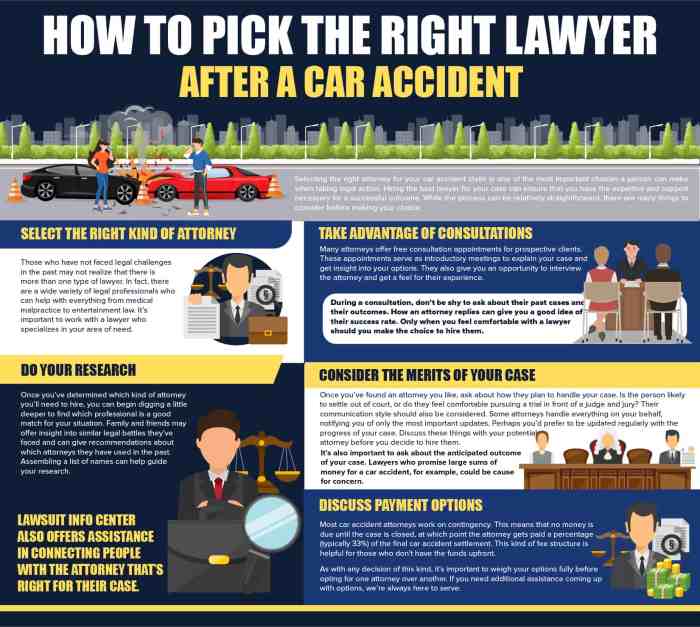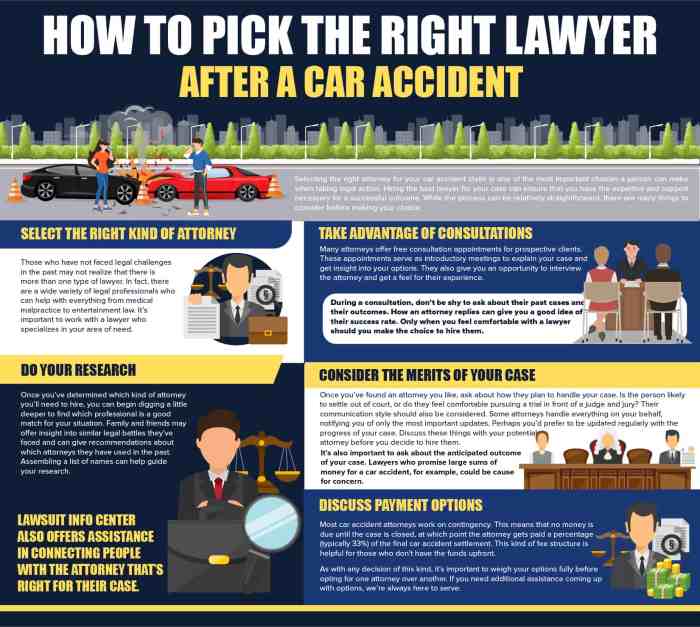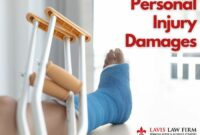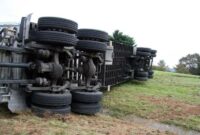Car accident lawsuit lawyers play a crucial role in navigating the complex legal landscape after a car accident. These legal professionals are equipped with the knowledge and experience to advocate for your rights and help you secure fair compensation for your injuries, damages, and losses.
Whether you’ve been involved in a minor fender bender or a serious collision, understanding your legal options and the intricacies of car accident lawsuits is essential. This guide provides valuable insights into the legal process, common issues, and strategies for maximizing your chances of a successful outcome.
Understanding Car Accident Lawsuits
Car accidents can have devastating consequences, causing physical injuries, emotional distress, and significant financial losses. If you’ve been involved in a car accident that wasn’t your fault, you may have the right to file a lawsuit to seek compensation for your damages.
Understanding the legal basis for car accident lawsuits and the elements required to win your case is crucial.
The Legal Basis for Car Accident Lawsuits
Car accident lawsuits are typically based on the principle of negligence. Negligence occurs when a person or entity fails to exercise reasonable care, resulting in harm to another person. To establish negligence in a car accident lawsuit, you must prove the following elements:
- Duty of Care:The defendant owed a duty of care to the plaintiff. This means that the defendant had a legal obligation to act reasonably to avoid causing harm to the plaintiff.
- Breach of Duty:The defendant breached their duty of care by acting negligently. This could involve speeding, driving under the influence, failing to yield, or other reckless driving behaviors.
- Causation:The defendant’s negligence was the direct cause of the plaintiff’s injuries and damages. This means that the accident wouldn’t have happened if the defendant had acted reasonably.
- Damages:The plaintiff suffered actual damages as a result of the accident. These damages can include medical expenses, lost wages, pain and suffering, and property damage.
Common Types of Car Accident Lawsuits, Car accident lawsuit lawyer
Car accident lawsuits can take various forms, depending on the circumstances of the accident and the nature of the injuries. Some common types of car accident lawsuits include:
- Negligence Lawsuits:These are the most common type of car accident lawsuit. They are based on the principle that the defendant’s negligence caused the accident and the plaintiff’s injuries.
- Product Liability Lawsuits:These lawsuits target the manufacturer or distributor of a defective vehicle part that contributed to the accident. For example, a lawsuit could be filed against a tire manufacturer if a tire blowout caused the accident.
- Wrongful Death Lawsuits:These lawsuits are filed when a person dies as a result of a car accident. The lawsuit seeks compensation for the deceased person’s family members for their loss of companionship, support, and income.
Elements to Prove in a Car Accident Lawsuit
To win a car accident lawsuit, you must present compelling evidence to prove each element of negligence. This evidence can include:
- Police Report:The police report from the accident scene provides crucial information about the circumstances of the accident, including the location, time, and contributing factors.
- Witness Testimony:Statements from witnesses who saw the accident can provide valuable insights into the events leading up to the collision and the actions of the drivers involved.
- Medical Records:Medical records document the extent of your injuries and the treatment you received. They are essential for proving the severity of your damages.
- Photos and Videos:Photographs and videos of the accident scene, the damaged vehicles, and your injuries can help visualize the events and support your claims.
- Expert Testimony:In some cases, you may need expert testimony from accident reconstructionists, medical professionals, or other specialists to support your claims and provide technical evidence.
Types of Damages in Car Accident Lawsuits
If you’ve been injured in a car accident, you may be entitled to compensation for your losses. This compensation is known as “damages,” and it can cover a wide range of expenses and losses.Damages in a car accident lawsuit are categorized as either economic or non-economic.
These categories help determine what types of losses are compensable and how they are calculated.
Economic Damages
Economic damages are quantifiable financial losses resulting directly from the accident. They are typically easier to calculate because they involve concrete expenses and lost income. Examples of economic damages include:
- Medical Expenses:This includes costs associated with treating injuries, such as doctor’s visits, hospital stays, medication, physical therapy, and any future medical care related to the accident.
- Lost Wages:This covers income lost due to being unable to work because of injuries sustained in the accident. It can include both current and future lost wages.
- Property Damage:This covers the cost of repairing or replacing damaged vehicles or other property involved in the accident. It also includes any deductible paid to an insurance company.
- Other Expenses:This can include other reasonable and necessary expenses related to the accident, such as transportation costs, childcare expenses, or home care services.
Non-Economic Damages
Non-economic damages are more subjective and intangible. They are harder to quantify as they represent the emotional and psychological impact of the accident. While not directly related to financial losses, they are often significant consequences of a car accident. Here are some examples:
- Pain and Suffering:This encompasses physical pain, emotional distress, and mental anguish caused by the accident and its aftermath. It can include the discomfort of injuries, the fear and anxiety experienced during the accident, and the emotional impact of long-term disability or disfigurement.
- Loss of Enjoyment of Life:This covers the inability to participate in activities and hobbies that were previously enjoyed due to injuries or limitations caused by the accident. It can include restrictions on physical activities, social interactions, or recreational pursuits.
- Loss of Consortium:This applies to spouses and can include the loss of companionship, affection, and support due to the injured spouse’s injuries. It recognizes the emotional and physical impact of the accident on the relationship.
Calculating Damages
Calculating damages can be complex and involves several factors. For economic damages, receipts, invoices, and pay stubs are used to support the claims. For non-economic damages, the severity and duration of injuries, the impact on daily life, and the individual’s circumstances are considered.
Damages = Economic Damages + Non-Economic Damages
The specific amount of damages awarded can vary significantly depending on the facts of the case, the severity of injuries, and the jurisdiction.
Finding the Right Car Accident Lawsuit Lawyer
Choosing the right legal representation is crucial for navigating the complexities of a car accident lawsuit. A skilled and experienced lawyer can significantly impact the outcome of your case, ensuring your rights are protected and you receive fair compensation for your losses.
Importance of Experience and Expertise in Car Accident Law
Experience and expertise in car accident law are paramount when choosing a lawyer. This specialized area of law involves a unique set of legal principles, procedures, and evidence. An attorney specializing in car accident lawsuits possesses a deep understanding of these intricacies, enabling them to effectively advocate for your best interests.
- They understand the intricacies of state and federal laws governing car accidents, including negligence, liability, and insurance regulations.
- They are familiar with the common types of injuries and damages arising from car accidents, allowing them to accurately assess the value of your claim.
- They have a proven track record of successfully handling car accident cases, demonstrating their ability to negotiate favorable settlements or win at trial.
Finding and Choosing a Qualified Lawyer
Finding a qualified car accident lawsuit lawyer involves a strategic approach. You should consider the following steps:
- Seek Referrals:Ask family, friends, colleagues, or other professionals for recommendations of reputable car accident lawyers in your area.
- Utilize Online Resources:Websites like Avvo, FindLaw, and Martindale-Hubbell allow you to search for lawyers based on location, practice area, and client reviews.
- Contact Bar Associations:Your state’s bar association maintains a directory of licensed attorneys, often including information about their specialties and experience.
- Consult with Multiple Lawyers:Schedule initial consultations with several lawyers to compare their experience, expertise, communication style, and fees.
- Assess Their Track Record:Inquire about the lawyer’s experience in handling car accident cases similar to yours, including their success rate in negotiating settlements or winning at trial.
- Consider Communication and Client Service:Choose a lawyer who is responsive, communicative, and attentive to your needs and concerns. They should be readily available to answer your questions and provide updates on your case.
- Review Fees and Payment Plans:Discuss the lawyer’s fee structure, including hourly rates, contingency fees, and any upfront costs. Ensure you understand the payment terms and potential expenses associated with the case.
The Legal Process of a Car Accident Lawsuit
Navigating the legal process of a car accident lawsuit can feel overwhelming, but understanding the steps involved can help you feel more prepared. A car accident lawsuit is a legal action taken by a person who has been injured in a car accident to seek compensation from the at-fault party.
The legal process involves a series of steps, from filing a claim to potentially going to trial.
Filing a Claim
Once you’ve been injured in a car accident, the first step is to file a claim with the insurance company of the at-fault driver. This is typically done through a written or online form. You’ll need to provide details about the accident, your injuries, and any medical bills.
The insurance company will then investigate the claim and determine whether to pay you compensation.
Negotiation
If the insurance company offers a settlement that you find unacceptable, you can negotiate with them to try to reach a more favorable agreement. This is often done with the help of a lawyer. A lawyer can help you understand your rights and options and can negotiate on your behalf.
Filing a Lawsuit
If you’re unable to reach a settlement with the insurance company, you may need to file a lawsuit. This is a formal legal action that will be heard in court. The lawsuit will allege that the other driver was negligent and caused your injuries.
Discovery
Once a lawsuit is filed, the parties will engage in a process called discovery. This is a period of time where both sides gather information about the case. This can involve things like taking depositions (sworn statements from witnesses), requesting documents, and inspecting evidence.
Trial
If the case doesn’t settle during discovery, it will go to trial. At trial, both sides will present their evidence to a judge or jury. The judge or jury will then decide whether the other driver was negligent and, if so, how much compensation you should receive.
Appeals
After a trial, the losing party may appeal the decision to a higher court. This is a process where the higher court reviews the decision of the lower court to see if there were any errors.
Flowchart of the Legal Process
The legal process of a car accident lawsuit can be illustrated by a flowchart.
- File a claim: The first step is to file a claim with the insurance company of the at-fault driver.
- Negotiate a settlement: If the insurance company offers a settlement that you find unacceptable, you can negotiate with them to try to reach a more favorable agreement.
- File a lawsuit: If you’re unable to reach a settlement with the insurance company, you may need to file a lawsuit.
- Discovery: Once a lawsuit is filed, the parties will engage in a process called discovery.
- Trial: If the case doesn’t settle during discovery, it will go to trial.
- Appeals: After a trial, the losing party may appeal the decision to a higher court.
Common Issues in Car Accident Lawsuits
Car accidents can be traumatic events, and the aftermath often involves navigating the complexities of legal proceedings. Understanding common issues that arise in car accident lawsuits can help you navigate this process more effectively. This section will delve into common defenses used by insurance companies, the impact of comparative negligence, and the critical role of evidence.
Common Defenses Used by Insurance Companies
Insurance companies are financially invested in minimizing payouts. They employ various defense strategies to reduce their liability or deny claims altogether. Here are some common defenses used in car accident lawsuits:
- Contesting Liability:Insurance companies might argue that the accident was not the fault of their insured driver. They might present evidence suggesting the other driver caused the accident or that the accident was unavoidable. For example, they might claim the other driver ran a red light or failed to yield the right of way.
- Claiming Contributory Negligence:Insurance companies might argue that the injured party contributed to the accident through their own negligence. For example, they might claim the injured party was texting while driving or was not wearing a seatbelt.
- Exaggerating Injuries:Insurance companies might argue that the injuries sustained by the injured party are not as severe as claimed. They might try to downplay the severity of the injuries or argue that they are pre-existing conditions unrelated to the accident.
- Denying Medical Expenses:Insurance companies might challenge the necessity or reasonableness of medical bills. They might argue that certain treatments were not necessary or that the charges are excessive.
Comparative Negligence
Comparative negligence is a legal doctrine that allocates fault for an accident among all parties involved, including the injured party. This means that even if the other driver was primarily responsible for the accident, the injured party’s own negligence can reduce their compensation.
For example, if a court finds that the other driver was 80% at fault and the injured party was 20% at fault, the injured party’s compensation will be reduced by 20%.
This principle can significantly impact the outcome of a car accident lawsuit. It is crucial to understand the concept of comparative negligence and how it can affect your case.
The Role of Evidence in Car Accident Lawsuits
Evidence plays a crucial role in proving liability and damages in car accident lawsuits. The following types of evidence are commonly used:
- Police Reports:Police reports document the details of the accident, including the location, time, and involved parties. They often include witness statements and diagrams of the accident scene.
- Witness Testimony:Eyewitness accounts can provide valuable information about the events leading up to the accident. This can include statements from passengers, pedestrians, or other drivers who witnessed the accident.
- Medical Records:Medical records document the nature and extent of the injured party’s injuries. This includes records from emergency rooms, hospitals, doctors’ offices, and physical therapists.
- Photographs and Videos:Photographs and videos of the accident scene, the damage to the vehicles, and the injured party’s injuries can provide visual evidence supporting the claims.
- Vehicle Data:Modern vehicles often contain event data recorders (EDRs) that record data about the vehicle’s speed, braking, and acceleration. This data can provide valuable information about the events leading up to the accident.
Negotiating a Settlement

After filing a car accident lawsuit, the next step is usually negotiating a settlement with the insurance company or the at-fault party. A settlement is an agreement between the parties involved to resolve the case without going to trial. This can be a complex process, but understanding the steps involved and the factors that influence negotiations can help you achieve a fair outcome.
Factors Influencing Settlement Negotiations
Settlement negotiations are influenced by various factors, including:
- The severity of your injuries and damages. This includes medical bills, lost wages, pain and suffering, and property damage. The more significant your damages, the higher the potential settlement amount.
- The strength of your case. This depends on the evidence you have to support your claims, such as police reports, medical records, and witness statements. A strong case increases your leverage in negotiations.
- The insurance company’s evaluation of your claim. Insurance companies have their own methods for assessing the value of claims, and their initial offer may not reflect the full extent of your damages.
- The at-fault party’s insurance policy limits. The maximum amount you can recover is limited by the at-fault party’s insurance policy coverage.
- Your willingness to settle. If you are willing to settle, you may be more likely to reach an agreement. However, you should not settle for an amount that is less than what you believe is fair.
The Importance of Legal Representation in Settlement Negotiations
Having an experienced car accident lawyer on your side during settlement negotiations is crucial. Here’s why:
- Knowledge of the Law:A lawyer understands the complexities of car accident law and can ensure your rights are protected. They can also identify potential legal issues that could affect your case and negotiate a settlement that reflects your legal entitlements.
- Negotiation Skills:Lawyers are skilled negotiators and can effectively communicate with insurance companies and opposing counsel to achieve a favorable outcome. They can use their expertise to present a strong case and advocate for your interests.
- Understanding of Insurance Company Tactics:Insurance companies often use tactics to minimize payouts. A lawyer can recognize these tactics and counter them to ensure you receive a fair settlement.
- Protection from Unfair Offers:Lawyers can protect you from accepting unfair or low settlement offers. They can evaluate the offer against the value of your claim and advise you on whether to accept or reject it.
Step-by-Step Guide to Negotiating a Settlement
Here’s a step-by-step guide to negotiating a settlement in a car accident lawsuit:
- Gather Evidence:Compile all relevant documentation, including medical records, police reports, photos of the accident scene, and witness statements. This evidence will support your claims and strengthen your negotiation position.
- Evaluate Your Damages:Calculate the total amount of your damages, including medical expenses, lost wages, pain and suffering, and property damage. This will help you determine a reasonable settlement amount.
- Communicate with the Insurance Company:Once you have gathered evidence and calculated your damages, contact the at-fault party’s insurance company to initiate settlement negotiations. Clearly communicate your claims and the amount you are seeking.
- Negotiate with the Insurance Company:The insurance company will likely make an initial offer, which may be lower than your desired amount. Be prepared to negotiate and counter their offer. Your lawyer can assist you in this process.
- Consider a Settlement Offer:If the insurance company makes a reasonable offer, carefully consider whether to accept it. Weigh the pros and cons of settling versus going to trial. Your lawyer can provide valuable advice on this decision.
- Sign a Settlement Agreement:If you decide to settle, you will need to sign a settlement agreement. This agreement Artikels the terms of the settlement, including the amount you will receive and any conditions or releases. It’s essential to review the agreement carefully before signing.
Important Considerations
- Time Limits:Be aware of any deadlines for filing a lawsuit or negotiating a settlement. Failing to meet these deadlines could affect your rights.
- Medical Treatment:Continue seeking medical treatment for your injuries, even during settlement negotiations. This ensures your recovery and provides evidence of your damages.
- Don’t Settle Too Quickly:Don’t feel pressured to settle too quickly, especially if you are unsure about the offer or the potential outcome of your case. Your lawyer can advise you on the best course of action.
Going to Trial: Car Accident Lawsuit Lawyer
If you and the insurance company can’t agree on a settlement, your car accident lawsuit will go to trial. This means a judge or jury will decide who is at fault for the accident and how much compensation you deserve.
Trial Process
Going to trial in a car accident lawsuit is a complex process. Here are the different phases:
Jury Selection
The first step is jury selection. The lawyers for both sides will question potential jurors to determine if they are impartial and capable of making a fair decision. This process is called voir dire.
Opening Statements
Once the jury is selected, the lawyers for both sides will give opening statements. These statements will Artikel the case and the evidence that will be presented.
Presentation of Evidence
Next, both sides will present their evidence. This may include witness testimony, photographs, medical records, and expert opinions. The plaintiff’s lawyer will present evidence to support their claim, while the defendant’s lawyer will present evidence to defend their client.
Closing Arguments
After the evidence is presented, the lawyers for both sides will give closing arguments. These arguments will summarize the evidence and persuade the jury to rule in their favor.
Jury Deliberation
The jury will then retire to a private room to deliberate and reach a verdict. The jury must decide whether the defendant is liable for the accident and, if so, how much compensation the plaintiff should receive.
Verdict
The jury will return to the courtroom and announce their verdict. The judge will then enter a judgment based on the jury’s verdict.
The Role of the Jury
The jury plays a crucial role in car accident lawsuits. They are responsible for deciding the following:
- Whether the defendant was negligent in causing the accident.
- The extent of the plaintiff’s damages.
- The amount of compensation the plaintiff should receive.
The jury’s decision is binding on both parties. This means that the parties must accept the jury’s verdict, even if they disagree with it.
Example of a Trial
Imagine a car accident lawsuit where the plaintiff claims that the defendant ran a red light and caused the accident. The plaintiff has medical records showing their injuries and witness testimony from other drivers who saw the accident. The defendant claims that they were not at fault and that the plaintiff ran the red light.
The defendant presents evidence to support their claim, including witness testimony and photographs of the accident scene.The jury would then have to weigh the evidence presented by both sides and decide who is at fault for the accident. If the jury finds that the defendant was negligent, they would then have to determine the amount of compensation the plaintiff should receive for their injuries and other damages.
Tips for Avoiding Car Accidents
While no one can guarantee complete safety on the road, adopting safe driving practices can significantly reduce the risk of accidents. By understanding common driving mistakes and implementing defensive driving techniques, you can contribute to a safer driving environment for yourself and others.
Common Driving Mistakes
It’s essential to be aware of common driving mistakes that often lead to accidents. Recognizing these errors can help you avoid them and stay safe on the road.
- Distracted Driving:Using cell phones, texting, eating, or applying makeup while driving significantly increases the risk of accidents. These distractions take your attention away from the road, hindering your ability to react quickly to changing conditions.
- Speeding:Exceeding the speed limit reduces your reaction time and increases the severity of an accident if one occurs. It also makes it more challenging to control your vehicle in emergencies.
- Driving Under the Influence:Driving under the influence of alcohol or drugs impairs your judgment, coordination, and reaction time, making you a danger to yourself and others on the road.
- Drowsy Driving:Driving while tired can be as dangerous as driving under the influence. Fatigue impairs your judgment, alertness, and reaction time, making you more likely to make mistakes.
- Aggressive Driving:Tailgating, speeding, weaving in and out of traffic, and making sudden lane changes are all examples of aggressive driving. These behaviors increase the risk of accidents and can escalate into road rage.
- Failure to Yield:Failing to yield to pedestrians, cyclists, or other vehicles at intersections or crosswalks can result in serious accidents.
- Improper Lane Changes:Changing lanes without signaling or checking your blind spots can lead to collisions with other vehicles.
- Ignoring Traffic Signals:Running red lights or stop signs is a major cause of accidents. It puts you and others at risk by disregarding the established rules of the road.
Defensive Driving Techniques
Defensive driving involves anticipating potential hazards and taking proactive steps to avoid accidents. It emphasizes being aware of your surroundings and making safe decisions.
- Maintain a Safe Following Distance:This provides you with adequate time to react to sudden braking or changes in traffic conditions. A good rule of thumb is to maintain a distance of at least three seconds behind the vehicle in front of you.
- Scan the Road Ahead:Constantly scan the road ahead for potential hazards, including other vehicles, pedestrians, cyclists, and road conditions. This allows you to anticipate potential problems and react accordingly.
- Check Your Mirrors Regularly:Regularly check your rearview and side mirrors to stay aware of traffic behind you. This helps you anticipate potential lane changes or sudden braking.
- Be Aware of Your Blind Spots:Use your mirrors and turn your head to check your blind spots before changing lanes or merging into traffic. Blind spots are areas that are not visible in your mirrors.
- Use Your Turn Signals:Signal your intentions to other drivers by using your turn signals when changing lanes, turning, or merging. This allows other drivers to anticipate your movements and react accordingly.
- Avoid Distractions:Put your phone away, avoid eating or applying makeup while driving, and resist the urge to check your phone or other devices. Focus your attention on the road.
- Be Prepared to Stop:Always be prepared to stop suddenly by keeping your foot lightly on the brake pedal. This allows you to react quickly to unexpected situations.
Outcome Summary
Navigating a car accident lawsuit can be daunting, but with the right legal guidance, you can confidently pursue your rightful compensation. Remember, understanding your rights and seeking expert legal counsel are essential steps towards achieving a positive resolution.
FAQ Insights
How do I find a qualified car accident lawsuit lawyer?
Look for lawyers with experience in car accident law, good communication skills, and a proven track record of success. You can also ask for referrals from trusted sources.
What are the common types of damages in a car accident lawsuit?
Damages can include medical expenses, lost wages, pain and suffering, property damage, and emotional distress.
How long does it take to resolve a car accident lawsuit?
The duration of a lawsuit varies depending on factors like the complexity of the case, insurance negotiations, and potential court proceedings.
What happens if I can’t afford a lawyer?
Many lawyers offer free consultations and work on a contingency fee basis, meaning they only get paid if they win your case.
Can I represent myself in a car accident lawsuit?
While self-representation is possible, it’s highly recommended to seek legal counsel due to the complexities of car accident law.




